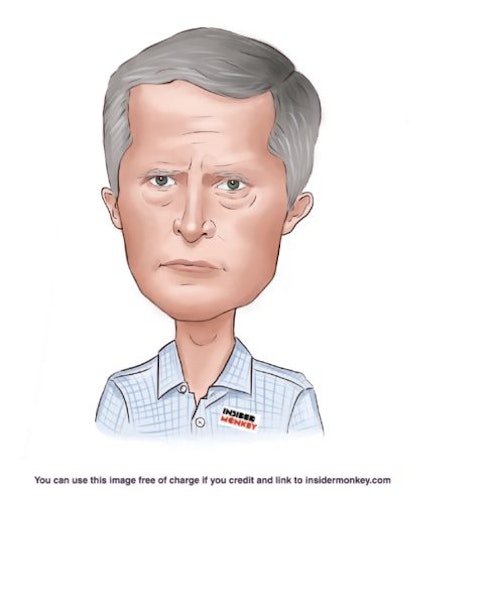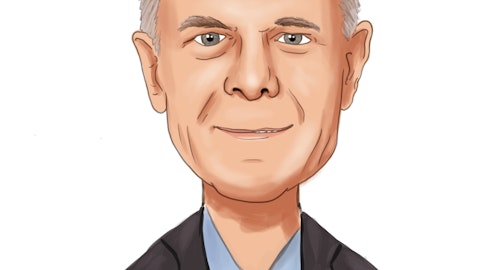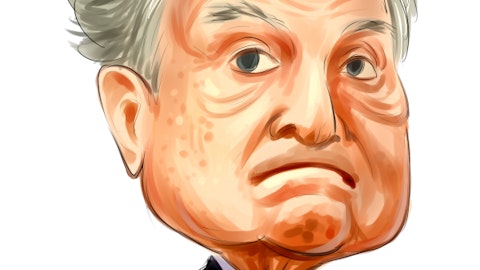In this article we take a look at billionaire Andreas Halvorsen’s top 10 tech dividend stocks. To skip our detailed analysis of Halvorsen’s latest portfolio updates, go directly to 5 Best Dividend Stocks to Buy According to Billionaire Andreas Halvorsen.
Andreas Halvorsen operates the Vikings Global hedge fund. The Norwegian business mogul was born in 1961. He has an extensive background that includes working in Morgan Stanley’s investment banking division before he became the senior managing director at Tiger Management Corp. This position allowed him to work with famed hedge fund manager Julian Robertson.
Connecticut-based Viking Global manages assets worth more than $36.367 billion spread out across 12 investment vehicles or funds. The company has 49 financial advisors that facilitate its management and many other employees contributing to its operations. Its investments are spread out in private and public markets across the world. Viking Global boosted its stock portfolio with 25 new additions in the fourth quarter of 2020 while bolstering its position in 18 stocks and reducing 44 stocks. These adjustments were necessary to maintain a healthy profile of the best dividend stocks to maximize returns.
Company Background
Viking Global has been around since 1999. David C. Ott and Andreas Halvorsen have direct and indirect ownership of the fund through Viking Global Partners, LLC, and Viking Global. It also features fund families that have been around since the company’s first year of operations. This means that the first fund family was started in 1999 while the others were launched in 2009 and 2015.
The hedge fund has a diverse clientele that includes individual investors, corporate clients, trusts, funds of funds, government institutions, pensions and endowments, and charities.
Investment Philosophy
Having the right strategy is an important part of success for any hedge fund, including Viking Global, which uses three strategies, one for each fund family.
- The Viking Global Equities Funds, which has been around since 1999, consists of long and short hedge funds.
- The Viking Long Funds, which has been operating since 2009, consists of long funds.
- Viking Global Opportunities Funds, which was launched in 2015, feature liquid and illiquid funds.
The three fund families tap into private and public investments to boost growth, although each fund deploys its strategic approaches for more efficiency.

Ole Andreas Halvorsen of Viking Global
Viking Global Equities Funds is the oldest investment arm of the hedge fund. Viking Global relies on gross exposure to determine the leverage profile of the funds. The company’s goal is to ensure that gross exposure stays below 250% while net exposure in the family of funds is often under 60%. The Viking Long Funds uses the same strategies, but it is oriented towards long-term yields rather than securing a wider base. The Viking Global Opportunities Funds take a more aggressive approach that targets liquid and illiquid opportunities worldwide as part of its earnings maximization strategy.
Viking Global is one of the many hedge funds that use a hedged approach to achieve more growth. The strategy often entails minimizing net exposure while also taking long and short positions. The hedge fund expects the combination of strategies to help it outperform the market in the long-term. However, not all hedge funds are able to sustain their positive returns. The financial landscape is going through changes such as automation which many believe will threaten their jobs. The hedge fund industry, in particular, has been under a lot of pressure due to its failure to keep up with market indices which have been delivering better unhedged returns. The situation has been ruining the hedge fund industry’s reputation. On the other hand, Insider Monkey’s research was able to identify in advance a select group of hedge fund holdings that outperformed the S&P 500 ETFs by more than 124 percentage points since March 2017. Between March 2017 and February 26th 2021 our monthly newsletter’s stock picks returned 197.2%, vs. 72.4% for the SPY. Our stock picks outperformed the market by more than 124 percentage points (see the details here). We were also able to identify in advance a select group of hedge fund holdings that significantly underperformed the market. We have been tracking and sharing the list of these stocks since February 2017 and they lost 13% through November 16th. That’s why we believe hedge fund sentiment is an extremely useful indicator that investors should pay attention to. You can subscribe to our free newsletter on our homepage to receive our stories in your inbox.
Viking Global’s 13F portfolio’s market value rallied to $36.367 billion by the end of Q4 2020 from Q3 2020. BBIO, Microsoft, and three other large-cap stocks in Viking’s portfolio covered 17.30% of the 13F portfolio by December 31, 2020. The investment fund’s portfolio is spread across multiple high-growth industries, with 19.89% invested in IT, 20% in finance, while the lion’s share at 32.23% is invested in the healthcare industry.
Viking Global’s 10 Best Dividend Stock Picks
Viking’s portfolio featured stocks from 114 companies by December 31, 2020. Here are the top ten best dividend stocks in its portfolio:
10. Chubb Limited (NYSE: CB)
The number of hedge fund investors that own this stock declined to 34 in Q4 2020 from 45 in Q3 2020. Viking Global is one of the remaining investors, with 2.71 million shares as its stake in the company, making it the biggest hedge fund stake, followed by is Adage Capital Management which owns 996,446 CB shares. CB’s dividend yield is 1.92%.
Chubb is one of the top commercial line insurance companies in the U.S and one of the largest players in the property and casualty segment globally. The company provides causality and property insurance for personal and commercial segments. It also provides life insurance, supplemental health insurance, and reinsurance to customers in 54 countries.
Chubb reported a net income of $3.53 billion for the full year 2020, which was a notable decline from the $4.45 billion net profit reported in the previous year. Its shares surged by more than 30.8% in the last 12 months.
Davis Funds had made the following statement about Chubb Limited in an investor letter:
“Chubb is now among the Fund’s largest P&C holdings at 5.2% and illustrates well why we thought there was an opportunity to add to our P&C names. Through September 30, 2020, Chubb had returned −24% for the year, reflecting investors’ fears that (1) the insurance industry would be compelled to cover substantial business interruption claims that were never intended as part of insured’s policies, (2) declining long-term rates would diminish the value of “float” (i.e., customers’ funds that insurers get to hold and invest until claims are paid), and (3) adverse trends (pre-dating the pandemic) in insured loss rates (e.g., rising litigation and settlement costs, increased frequency and severity of catastrophe losses, etc.).
With industry economics already soft, it was only a matter of time before insurance pricing would have to adjust. In fact, P&C pricing had already begun to increase in a number of business lines before COVID hit, and that trend has only increased and broadened since then. Chubb disclosed in Q3 2020 that North American commercial P&C pricing increased by more than 15% in aggregate. Some of the price increase will go to cover rising insurance loss rates, but we certainly do anticipate some dropping into underwriting profit too. Admittedly, some of that increased underwriting profit will itself get offset by a decline in investment income owing to lower interest rates, but that is a “feature,” if you will, of P&C insurance companies. Unlike a bank, where the floor on its deposit funding costs practically speaking is zero, there is in theory no reason underwriting profit cannot increase to offset low interest rates, so it is feasible for its earnings to “normalize” far in advance of an eventual rise in long-term rates.
With respect to the setting of loss reserves, we have always admired Chubb’s conservative approach in establishing cautious initial loss estimates and in recognizing the bad news first. In terms of COVID related losses, Chubb reserved $1.4 billion for customers’ claims in the second quarter, the majority of which were “incurred but not reported” loss estimates for professional and general liability lines that would be the second- and third-order impacts of the virus. Like the banks’ “life-of-loan” reserving described above, Chubb has made an honest effort to put all of COVID’s financial impact behind it.
When we started adding to our position in Chubb this year, it was valued at 1.6x tangible book value, and we expect it has the potential to earn a mid-teens return on capital over time and for it to grow decently and gain market share over time.”
9. Becton, Dickinson and Company (NYSE:BDX)
It had 65 hedge funds owning stake in it in 4Q 2020, which was slightly higher than the 62 in Q3. Vikings Global was one of the hedge funds, with 511584 shares in the company. BDX’s largest hedge fund investor in Q4 was Fundsmith LLP with 4.35 million shares, while Generation Investment Management was a close second with 3.85 million shares. Becton, Dickinson, and Company has a 1.27% dividend yield.
Becton, Dickson recently earned the FDA’s 510(k) approval of its Pristine™ Long-Term Hemodialysis Catheter. The company revealed that it plans to roll out the product for commercial use in the following month. Pristine Access Technologies, an Israeli-based company created the pristine catheter. Becton acquired the Israeli firm in July last year. It also announced the acquisition of GSL Solutions which makes smart medication devices.
8. Parker-Hannifin Corporation (NYSE: PH)
Parker-Hannifin Corporation attracted 56 out of 887 hedge funds to own its stock in Q4 2020, a slight improvement from the 51 hedge funds in the company during the previous quarter. Viking Global was among those companies with 1.68 million shares. PH has a 1.10% dividend yield.
Parker-Hannifin Corporation deals with motion and control technologies. The Ohio-based company has a sizable market capitalization at $41.4 billion. It has achieved a 17.90% return since the start of the year, boosting its 12-month performance by 131.21%. Investment management firm Oakmark Funds had the following to say about Parker-Hannifin in its latest investor letter:
“Parker Hannifin approached our estimates of intrinsic value and were, therefore, eliminated during the period. The company was a longstanding investment of the fund and produced successful outcomes. We believe Parker Hannifin, one of our longest tenured positions, is a high-quality, well-managed industrial with strong competitive positions in good end markets. However, after the market price reflected these positives, we elected to sell to pursue more attractive alternatives that were priced at steeper discounts to our estimates of intrinsic value.”
7. JPMorgan Chase & Co. (NYSE:JPM)
JPM is one of the most favored stocks amongst hedge funds with 112 of 887 hedge funds owning stakes in it. The company has a 2.35% dividend yield.
Viking Global is JPM’s 8th largest hedge fund shareholder with 8.5 million shares. Tom Russo, one of the most popular and successful investors, has a sizable stake in the banking giant for numerous years. 2020 was not the best year for JPM, but the company managed to bounce back quickly and has already gained by 12% so far.
Following Jamie Dimon seems to be a smart move because he seems to have access to JPMorgan Chase’s insider information. For example, he scooped up 500,000 shares at $34 per share in the company in 2012. This was when JPM’s shares plummeted from $45 to $33, courtesy of the London Whale scandal. His previous share purchase was in 2007, suggesting that he was aware that its shares were undervalued—a smart move considering that JPM’s shares are currently worth more than $150 per share.
Dimon made more than $60 million from his investment in JPM shares. JP Morgan announced a share buyback program in December 2020, in which it revealed plans to repurchase shares worth $30 billion. The stock has so far gained by more than 25% since the announcement. The stock still has some potential upside which could push the price past the $160 mark. VLTAVA Fund released an investor letter in Q2 and had this to say about JPM:
“In the quarter just ended, we bought shares of JP Morgan. In our opinion, among all the world’s large banks, this one is the best managed and financially strongest. It did very well already in the recession of 2008, when it remained profitable and did not require government help.”
6. Cigna Corporation (NYSE: CI)
Cigna had 57 hedge funds that owned its shares in Q4 2020, a slight decline from 62 in the previous quarter. Viking Global is one of them, with 1.95 million shares in the company by the end of the last quarter, making it the stock’s highest shareholder. The second highest hedge fund stake was Glenview Capital, at 1.26 million shares. It has a dividend yield of 1.58%.
Cigna provides a variety of products in the healthcare segments, including accident, life and health insurance, as well as Medicaid and Medicare products. Its primary market is the U.S, although it has operations in numerous international markets.
Artisan Partners Limited Partnership released the following statement regarding Cigna in its investor letter for Q4 2020:
“New purchases include Cigna. Cigna is a leading managed care company which operates through the following major segments: health services, integrated medical, international markets and group disability. It’s one of the few managed care organizations in the United States with the scale and size to compete effectively. Cigna has recently focused on deleveraging its balance sheet and further diversifying its business, after completing the Express Scripts acquisition in late 2018. Additionally, the company has partnered with Amazon, which will offer two new pharmacy options—including a self-pay offering. Cigna will administer the self-pay option through its health services division Evernorth. The partnership should be one of many strong earnings drivers for Cigna, which we believe is currently trading at an attractive valuation.”
Halvorsen believes that Cigna’s impressive profile is enough for it to secure a spot in as one of the top 10 best dividend stocks.
Click to continue reading and see the Viking Global’s Top 5 Best Dividend Stock Picks.
Suggested articles:
- Top 10 Energy Sector Stocks for 2021
- Billionaire Mario Gabelli’s Top 10 Stock Picks
- 15 Fastest-Growing Fintech Companies
Disclosure: None. 10 Best Dividend Stocks to Buy According to Billionaire Andreas Halvorsen is originally published on Insider Monkey.





